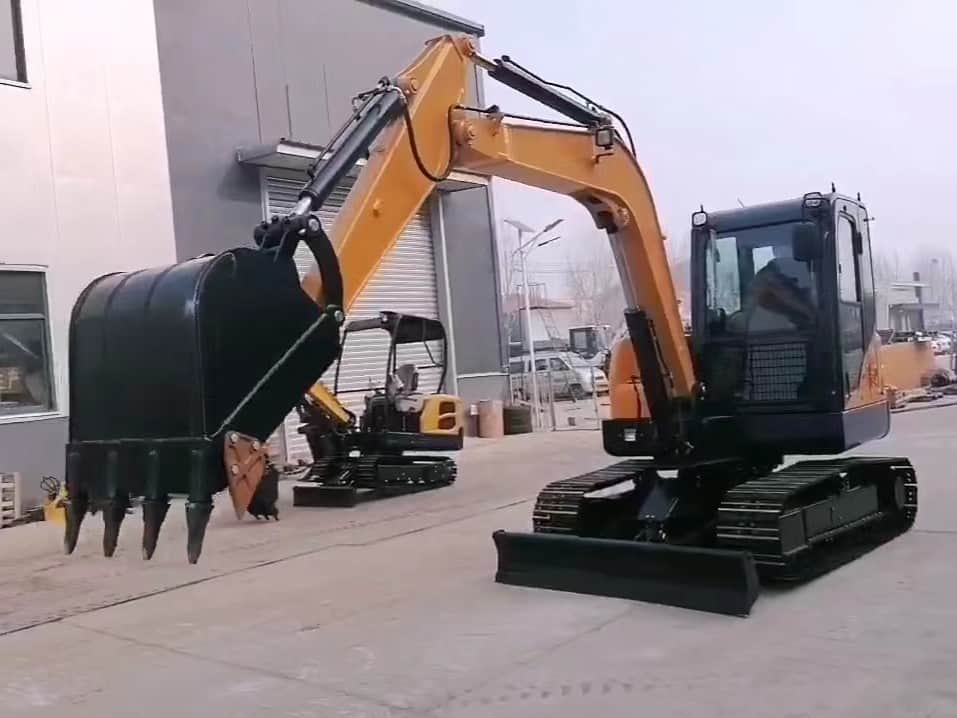The demand for mini excavators is increasing day by day. The main reason behind this is that they are very versatile and can be used in a variety of construction projects. This compact excavator is relatively cheaper than other excavators.
For those who are not familiar, a mini excavator is a construction vehicle that is used for various purposes such as digging trenches, holes, and foundations.
The importance of this compact digging tool in the construction industry can’t be overlooked. Since they are useful to serve multi-purpose, without them, construction projects would be very difficult to complete.
Although they are small in size, grave diggers pack a lot of power. They can easily dig through tough soil and rock. If you are looking for a machine that can help you with your construction projects, then a mini excavator is the way to go.
In this guide, we will take you through the complete manufacturing process of mini excavators.
The process of manufacturing a mini excavator involves several steps that are discussed in this article below.
1. Design and Development
The first step in the manufacturing process of a compact excavator is the design and development of the machine.
This involves the creation of blueprints and drawings of the excavator by engineers. The designing part also involves creating a prototype of the machine which is then tested for its performance.
Here are the vital considerations that engineers take note of when deciding on the design of an excavator.
Decide the Size & Weight
The first step in the design of a mini excavator is to decide on the size and weight of the machine. The size of the machine will determine how much digging power it has.
The weight of the machine will determine how easy it is to move around.
Choose the Type of Engine
Once the size and weight have been decided, the next step is to choose the type of engine. There are two types of engines that can be used in a mini excavator: gasoline and diesel.
Gasoline engines are less expensive, but they are not as powerful as diesel engines. Diesel engines are more expensive, but they are more powerful and durable.
Choose the Type of Tracks
The next step is to choose the type of tracks that will be used. There are two types of mini excavator tracks: steel and rubber. Steel tracks are more durable and can handle more weight, but they are also more expensive.
Rubber tracks excavators are less expensive, but they are not as durable and cannot handle as much weight.
Choose the Types of Attachments
The last step in the design process is to choose the mini excavator attachments that will be used. The most common attachment is the bucket.
The bucket is used to scoop up soil, sand, and gravel. Other attachments include a backhoe, a trencher, and a grader blade.
Once the design process is complete, the next step is to build the mini excavator is welding the frame.
2. Welding the Frame
The welding process in mini excavator manufacturing is quite different from than welding process of other excavators. In the guide ahead, we will briefly discuss the welding process of mini excavators.
The first thing that you need to know is that there are two types of welding processes used in mini excavator manufacturing. These two processes are MIG & TIG welding.
MIG Welding
MIG welding is the most common welding process used in mini excavator manufacturing. In this process, an electrode is used to create an arc between the metal and the welding machine.
This arc then melts the metals, which are then joined together.
TIG Welding
TIG welding, on the other hand, uses a tungsten electrode to create an arc. This arc is then used to heat the metals, which are then joined together.
The main advantage of MIG welding over TIG welding is that it is much faster. However, the downside is that it produces more fumes and welds are not as strong as TIG welds.
Furthermore, the manufacturers cut the pieces of metal that will be used.
- The metal must be cut to the correct size and shape.
- The next step is to join the pieces of metal together. This is performed by welding them together.
- The last step is to add any reinforcements that are needed. Reinforcements are added to areas that are under a lot of stress. This helps to prevent the frame from breaking.
So, if you are planning to buy a mini excavator, you should be familiar with the welding process.
3. Assembly
The next step is to assemble all the parts of the mini excavator. This is done by welding, bolting, or riveting the various parts together.
The process also involves installing the tracks and wheels on the excavator.
Steps in assembling mini excavator:
Add the Tracks
The mini excavator tracks are the first thing that needs to be added during the assembly process. They need to be placed on the frame so that they are level and even.
Install the Engine
The engine is the next thing that needs to be installed. It is important to make sure that the engine is properly secured to the frame.
The mini excavator engine is usually added last because it is the heaviest part of the mini excavator. The engine must be securely attached to the frame.
Attach the Bucket
The grading bucket for a mini excavator is one of the most important attachments to a mini excavator. Mini excavator buckets are used to dig trenches and holes.
Attach the Backhoe
The backhoe is another important attachment. It is used to excavate large amounts of dirt and soil.
Attach the Trencher
The mini excavator trencher is used to dig trenches. It is a long, narrow attachment that is placed on the back of the mini excavator. Also, it’s vital to attach a trencher attachment for the mini excavator.
Attach the Grader Blade
The grader blade is used to level off areas of land. It is a large, flat mini excavator blade attachment that is placed on the front of the mini excavator.
After all of the attachments have been added, the mini excavator is now ready to use. However, before directly sending them to the marketplace it is important to test them. This is to ensure that the mini excavator is able to operate properly.
This is also to ensure that the mini excavator is able to withstand the wear and tear of construction projects and is safe to use.
It can make your job easier and help you get the job done without obstacles.
4. Testing of Mini Excavators
Once the mini excavator has been assembled, it is then put through a series of tests to ensure that it is safe and effective.
The mini excavator tests include load testing, performance testing, and safety testing. Once the excavator has passed all these tests, it is then ready for use.
Here’s a brief overview of mini excavator testing.
Attaching Excavator to Test Stand
The first step in testing a mini excavator is to attach it to a test stand. This stand will support the weight of the machine and allow it to move freely. The next step is to start the engine and let it run for a few minutes.
This will allow the engine to warm up and get used to the workload. After the engine has warmed up, the mini excavator can be put through its paces.
The compact digging tool will be tested on a variety of surfaces. These surfaces can include dirt, gravel, sand, and pavement. The machine will be driven over these surfaces to make sure it can handle the terrain.
After the small excavator has been driven over all of the different surfaces, it will be put through a series of safety tests.
Some of the tests that mini excavators need to undergo include:
Operational Testing of Mini Digging Tool
This test is conducted to ensure that the mini excavator is able to operate smoothly and efficiently.
Load Testing of Compact Digging Equipment
This test is conducted to ensure that the mini excavator can handle the weight of the materials it will be lifting.
Safety Testing of a Mini Excavator
This test is conducted to ensure that the mini excavator is safe to use.
These are just some of the tests that mini excavators need to undergo before they can be used in construction projects.
Therefore, if you are planning to buy a mini excavator, you should make sure that it has undergone all the necessary tests.
Final Verdict
You already know that mini excavators are an essential part of the construction industry. They are used to dig trenches, holes, and other excavation work.
Without mini excavators, construction projects would be very difficult to complete. Although they are small in size, mini excavators pack a lot of power. They can easily dig through tough soil and rock.
This tool is very versatile and can be used for a variety of tasks. If you are looking for a machine that can help you with your construction projects, then a mini excavator is the way to go. Welcome to contact us for more information.

